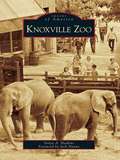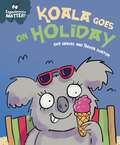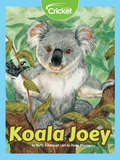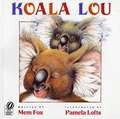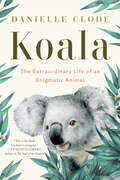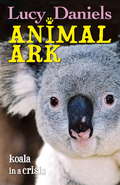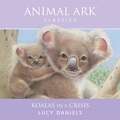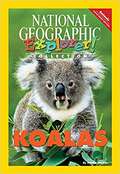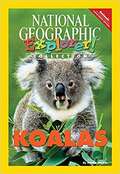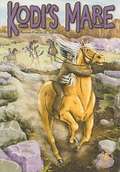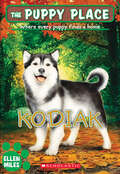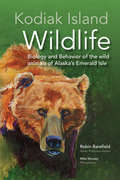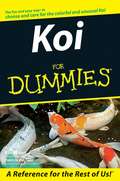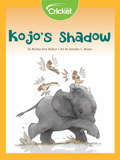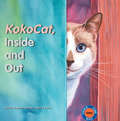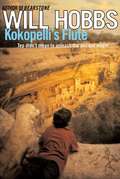- Table View
- List View
Knoxville Zoo (Images of America)
by Jack Hanna Sonya A. HaskinsThe Knoxville Zoo began as the Birthday Park Zoo in 1948. Due to a lack of expertise and funding, the Humane Society started proceedings to close the zoo in 1971 after the animals' welfare came under scrutiny. The zoo was saved by Guy Smith, a local television executive, who took on the job as the zoo's first director at a salary of $1 per year. Smith managed to convince the City of Knoxville and the local community to invest in this wonderful sanctuary. As the zoo's conditions improved and awareness was raised, a focus was placed on breeding threatened or endangered animals. These efforts were rewarded in 1978 with the birth of the first two African elephants to be born in the western hemisphere. This book celebrates the zoo's fascinating history with approximately 200 black-and-white images and detailed captions of its birth, rebirth, and journey toward becoming one of the nation's premier zoological institutions. This is a keepsake that zoo visitors and wildlife enthusiasts alike will enjoy.
Knuffle Bunny: A Cautionary Tale
by Mo WillemsTrixie, Daddy, and Knuffle Bunny take a trip to the neighborhood Laundromat. But the exciting adventure takes a dramatic turn when Trixie realizes somebunny was left behind. Using a combination of muted black-and-white photographs and expressive illustrations, this stunning book tells a brilliantly true-to-life tale about what happens when Daddy's in charge and things go terribly, hilariously wrong.
Koala (Animals in the Wild)
by Vincent ServentyFacts and insights into the world of the Koalas. Talks about their lives and describes its struggle for survival in a young child friendly way.
Koala Goes on Holiday (Experiences Matter)
by Sue GravesKoala Goes on Holiday offers a gentle introduction to the experience of being away from home for young children.This funny, charming story is the perfect way to introduce young children to the experience of being away from their familiar surroundings. Also included are suggestions for activities and ideas to talk through together to help children reflect on their own experiences.Koala is going on holiday, and everyone is very excited - everyone except Koala. She is nervous about being away from home. What if she doesn't like the beach? What if she doesn't like the food? Luckily, her sister is there to reassure her...The Experiences Matter series of picture books provide a gentle means of discussing experiences, boosting self-esteem and reinforcing good behaviour. Supports the Personal, Social and Emotional Development Area of Learning in the Early Years Foundation Stage, and is also suitable for use with children in KS1 and can be used to discuss values. Suitable for children under 5.
Koala Joey
by Buffy SilvermanDo you know what a baby koala, or a joey, looks like? Learn about how a joey spends its first year—from staying exclusively inside its mother's pouch, to venturing out into the world, and finally to moving into its own tree.
Koala Lou
by Mem Fox Pamela Lofts<p>Everyone loved soft, round, cuddly Koala Lou, but her mother loved her most of all and told her so a hundred times a day. As time passed and more little brothers and sisters were born, her mother became too busy to tell Koala Lou that she loved her. Koala Lou grew sad, and oh, how she longed to hear her mother say it once again. Then one day Koala Lou though of a brilliant plan to win back her mother's love and hear again those wonderful words, " Koala Lou, I DO love you!" <p>The warmth of Mem Fox's touching story of enduring mother love is perfectly captured in Pamela Loft's irresistible illustrations of this delectable little koala.</p>
Koala Makes the Right Choice: A book about choices and consequences (Behaviour Matters #37)
by Sue GravesKoala Makes the Right Choice offers a gentle introduction to the concepts of choice and consequence.This funny, charming story is the perfect way to introduce young children to choices, and helps them find ways to make decisions and understand consequences. Also included are suggestions for activities and ideas to talk through together to help children understand their behaviour.The Behaviour Matters series of picture books provide a gentle means of discussing emotions, boosting self-esteem and reinforcing good behaviour. Supports the Personal, Social and Emotional Development Area of Learning in the Early Years Foundation Stage, and is also suitable for use with children in KS1 and can be used to discuss values. Suitable for children under 5.
Koala: A Natural History And An Uncertain Future
by Danielle ClodeA New Scientist Best Popular Science Book of the Year "This is the book I’ve been waiting for." —Sy Montgomery, author of The Soul of an Octopus An Australian biologist delves into the extraordinary world of koalas, from their ancient ancestors to the current threats to their survival. Koalas regularly appeared in Australian biologist Danielle Clode’s backyard, but it was only when a bushfire threatened that she truly paid them attention. She soon realized how much she had to learn about these complex and mysterious animals. In vivid, descriptive prose, Clode embarks on a delightful and surprising journey through evolutionary biology, natural history, and ecology to understand where these enigmatic animals came from and what their future may hold. She begins her search with the fossils of ancient giant koalas, delving into why the modern koala has become the lone survivor of a once-diverse family of uniquely Australian marsupials. Koala investigates the remarkable physiology of these charismatic creatures. Born the size of tiny “jellybeans,” joeys face an uphill battle, from crawling into their mother’s pouch to being weaned onto a toxic diet of gum-tree leaves, the koalas’ single source of food. Clode explores the complex relationship and unexpected connections between this endearing species and humans. She explains how koalas are simultaneously threatened with extinction in some areas due to disease, climate change, and increasing wildfires, while overpopulating forests in other parts of the country. Deeply researched and filled with wonder, Koala is both a tender and inquisitive paean to a species unlike any other and a call to ensure its survival.
Koalas
by Lynn M. StoneDescribes the physical characteristics, behavior, natural habitat, and relationship to humans of the marsupial that looks like a teddy bear.
Koalas (Animals Animals Animals)
by Alan Roocroft Alison TibbittsWhat do Koalas eat? Where do they live? How do they communicate with each other? What could kill the koala? This file should make an excellent embossed braille copy. Learn about the cute cuddly teddy bears of Australia in this easy reader about the gray marsupials. For younger readers.
Koalas (Nature's Children)
by Elizabeth MacleodDid you know koalas have pouches that point downward, or that they only feast on eucalyptus leaves, or that they smell like cough drops? Read this book to learn a lot about these interesting creatures.
Koalas (Readers)
by Laura MarshWith a seemingly permanent half-smile on their face, koalas are appealing to boys and girls alike. Filled with adorable photos, and carefully leveled text, this level 1 reader introduces beginning readers to these furry creatures, from cub to adult, exploring where they live, what they eat, and even the way they say "hello"—by touching noses!National Geographic supports K-12 educators with ELA Common Core Resources.Visit www.natgeoed.org/commoncore for more information.
Koalas in a Crisis (Animal Ark #17)
by Lucy DanielsAnimal Ark is the veterinary surgery run by Mandy Hope's parents. If there are animals to be protected or looked after, Mandy is always there to help.Mandy longs to see her first koala and she's not disappointed when she visits the wildlife sanctuary. But her joy turns to dismay when she learns that the koalas and their babies are threatened. Can Mandy save the koalas from starvation?KOALAS IN A CRISIS is one of the best-loved ANIMAL ARK stories. Have you read them all?
Koalas in a Crisis (Animal Ark #17)
by Lucy DanielsMandy longs to see her first koala and she's not disappointed when she visits the wildlife sanctuary. But her joy turns to dismay when she learns that the koalas and their babies are threatened. Can Mandy save the koalas from starvation?(P) Hodder Children's Books 1997
Koalas, Pathfinder Edition (National Geographic Explorer Collection)
by Sandra MarkleNIMAC-sourced textbook
Koalas, Pioneer Edition (National Geographic Explorer Collection)
by Sandra MarkleNIMAC-sourced textbook
Kodi's Mare
by Bonnie Highsmith TaylorKodi, a Navajo orphan, is sent to live at a mission home because his cousin cannot afford to raise him. But when he finds out his mare has been sold to a cruel rancher, Kodi runs away to save her.
Kodiak (The Puppy Place #56)
by Ellen MilesWelcome to the Puppy Place -- where every puppy finds a home!Lizzie Peterson and her friends are heading to a cabin in the woods for a girls' weekend. On the way, they spot and rescue Kodiak, an energetic Malamute stray with a mind of his own. Can Lizzie and her friends tame the wild pup and find him a home?
Kodiak Island Wildlife: Biology and Behavior of the wild animals of Alaska's Emerald Isle
by Robin BarefieldKodiak Island, nicknamed the Emerald Isle, gleams like a gem in the North Pacific. Lush green mountains soar skyward from the ocean, framing deep, fjord-like bays. The island's wet maritime climate and mild temperatures encourage thick vegetation growth, which provides sustenance for the abundant wildlife on the island. The Alaska Current flows northward near Kodiak, bringing warm water and nutrients to Alaska's frigid Gulf. These nutrients form the basis for one of the richest marine ecosystems in the world. Kodiak bears reign as the island's monarchs, which has among the densest brown bear populations on earth. They are one of the six endemic mammals found on Kodiak, while humans have introduced many other wild mammals to the Kodiak Archipelago. The ocean surrounding Kodiak teems with seals, sea otters, sea lions, porpoises, and whales, while bald eagles, puffins, rare black oystercatchers, and arctic terns (which migrate all the way from Antarctica) also call the archipelago home. Learn more about this beautiful North Pacific gem and its amazing wildlife—and the challenges the animals face, both human and natural—in this richly detailed book by local naturalist, wildlife biologist, and sportfishing guide Robin Barefield, with photographs by her husband, Mike Munsey.
Koi For Dummies
by R. D. Bartlett Patricia BartlettKnown throughout the world for its beauty and personality, koi is one of the most carefully bred fish species around. Raising koi is especially time-consuming and requires more than just sprinkling little flakes in the fish bowl. But thankfully, you don't have to be an expert to maintain your own koi pond. Koi For Dummies shows you how easy and fun it can be to own and care for these delicate fish. Whether building a pond or aquarium for the indoors or outdoors, this easy-to-understand guide explores all of your options. Clear, concise advice helps you: Appreciate your koi's beauty Build, design, and maintain your koi pond or aquarium Find and select koi and the proper supplies Keep your koi happy and healthy Treat your koi for parasites, bacterial infections, and viruses Breed and care for baby koi Show off your koi to other koi enthusiasts
Koi-Karpfen halten (How to... #1)
by Owen JonesDer Inhalt dieses Buches über Koi Gartenteiche und ähnliche Themen ist auf 18 Kapitel aufgeteilt, welche Ihnen helfen werden, einen Ort für Ihren Koi-Teich auszuwählen, ihn anzulgen und ganzjährlich zu warten und sich um Ihre kostbaren Fische in verschiedenen Jahreszeiten und sogar in besonders schlechten Wetterkonditionen zu kümmern. Es könnte Ihnen sogar dabei helfen, eine neue Karriere zu starten. Das Mindeste, was es tun wird, ist Ihnen hunderte professioneller Ratgeber zu ersparen. Als ein zusätzlicher Bonus gebe ich Ihnen die Erlaubnis, den Inhalt des Buches auf Ihrer Webseite oder Ihrem Blog/Newsletter zu nutzen, obwohl es besser wäre, wenn Sie den Inhalt mit Ihren eigenen Worten wiedergeben würden. Sie können das Buch ebenfalls aufteilen und die Artikel weiterverkaufen. Tatsächlich ist das einzige recht, welches Sie nicht haben der Weiterverkauf oder das Verschenken des Buches, wie Sie es erhalten haben. Wenn SIe Feedback haben, bitte schreiben Sie es bei der Quelle Ihres Kaufes oder senden Sie es mir unter owen@amiabledragon.com Sie können mehr Bücher wie dieses finden, wo Sie es gekauft haben.
Kojo's Shadow
by Na'Ima Bint RobertKojo is a young elephant. When he sees his shadow for the first time, he’s alarmed.
Koko's Kitten
by Francine PattersonThe real life experience of Koko, a gorilla in California who uses sign language, with a young kitten whom she loved and grieved over when it died.
KokoCat, Inside and Out
by Nancy Lane Lynda Graham-BarberOne day, KokoCat, a well-loved housecat, sees an open door, a chance to escape her pleasant life, to explore an exciting world outdoors. Once outside, she finds that life is more frightening and less enjoyable than she bargained for. Hungry, lost, and alone, KokoCat takes shelter under a dumpster and dreams of her former life inside. In vibrant images, KokoCat's story shows the reader that keeping a domestic cat indoors is better both for the well being and longevity of the cat as well as for the birds and wild animals on which a cat preys. The book's final page for parents and adults offers important information, provocative questions, and tips to increase young readers' awareness of this important animal health and welfare issue. Lynda Graham-Barber's abiding passions for writing and animals have intermingled for four-decades, as children's book editor, writing teacher, author of thirteen books, and animal rights advocate. The author, who holds an MFA in writing for children from Vermont College, lives in a small stone cottage, which she helped build, situated on 160 wooded acres in the Northeast Kingdom, Vermont, with her artist husband David and their rescued dog Biscuit. Nancy Lane has been an award-winning illustrator for the last twenty years. Her picture books include Call the Horse Lucky and A Home for Dakota (both from The Gryphon Press). She lives in the Finger Lakes region of upstate New York with her family and her rescued dog and cats.
Kokopelli's Flute
by Will HobbsTHE MAGIC HAD ALWAYS BEEN THERE. Tep Jones has always felt the magic of Picture House, an Anasazi cliff dwelling near the seed farm where he lives with his parents. But he could never have imagined what would happen to him on the night of a lunar eclipse, when he finds a bone flute left behind by grave robbers. Tep falls under the spell of a powerful ancient magic that traps him at night in the body of an animal. Only by unraveling the mysteries of Picture House can Tep save himself and his desperately ill mother. Does the enigmatic old Indian who calls himself Cricket hold the key to unlocking the secrets of the past? And can Tep find the answers in time?
